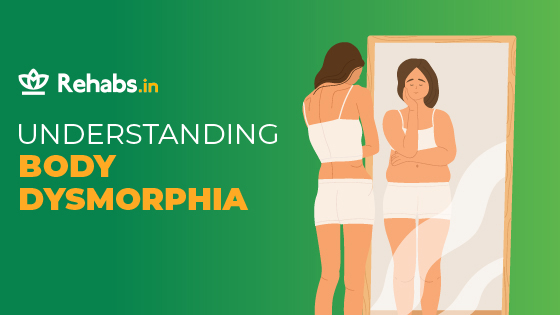Understanding body Dysmorphia

Twelve-year-old Riya hated her nose. She wondered why her nose wasn’t pointy and tiny like her barbie dolls. When she started putting clips on her nose, her mom thought nothing much of it. A couple of years later, when the COVID pandemic struck, and masks became mandatory, Riya started wearing masks even at home. She would not remove it even while eating, pushing the mask up to her nose. When her mom tried to assure her that removing the mask at home was safe, Riya replied, “I will never ever remove my mask even if the pandemic is over. That way, no one has to ever see my ugly nose.”
Riya could simply be vain about her looks, or she may be suffering from Body dysmorphic disorder. Only a professional psychologist can deduce that, and it may be helpful for Riya’s mother to seek further answers.
What is body dysmorphia?
Body dysmorphia, or Body dysmorphic disorder (BDD), is a condition that consists of a stressful or damaging obsession with imagined or minor defects in appearance. A person with BDD will keep obsessing over this perceived flaw and will try their best to hide it or get rid of it, often at the cost of physical, mental, or financial well-being.
BDD was first described over 100 years ago by Italian psychiatrist Enrico Morselli, who coined the term “dysmorphophobia,” from the Greek “dysmorphia”, which refers to ugliness.
What’s interesting to know that people suffer from BBD for years before seeking help as they are too ashamed and afraid of being termed vain and narcissistic. BDD can be more common among adolescents and young people as they are at an age when they are more worried about how they look and appear to their friends and prospective love interests. Social media has also significantly contributed to the rise of BDD in youth, where internet trolls and bullies can make one’s insecurities worse.
As per the Body Dysmorphic Disorder Foundation, celebrities from the past like the illustrious artist Andy Warhol, pop legend Michael Jackson, celebrated poet and novelist Sylvia Plath and the famous Franz Kafka all suffered from BDD. Current celebrities like the singer Billie Eilish, Hollywood actor Robert Pattinson and Bollywood actress Ileana D’Cruz also suffer from BDD.
Body dysmorphia symptoms
The newly published World Health Organization’s International Classification of Diseases 11 (ICD-11) states that BDD is characterised by persistent preoccupation with one or more perceived defects or flaws in appearance that are either unnoticeable or only slightly noticeable to others.
People suffering from body dysmorphic disorder often are extremely self-conscious. They are convinced that others are taking note of their perceived flaws or defects, judging them, and maybe even making fun of them. This perceived rejection from others may cause them to isolate themselves. This can affect their social, academic and occupational responsibilities.
Some of the repetitive physical acts displayed by individuals suffering from BDD include, constantly checking themselves in the mirror, excessive grooming, and asking others again and again if they look fine or if they can spot their flaws. Repetitive mental acts could include constantly comparing oneself to other individuals they perceive as perfect.
Individuals with BDD obsess over certain parts of their appearance, and often it’s the face/head, especially the skin, nose, and hair. Over their lifetime, individuals with BDD may get preoccupied with more than 5 – 7 different body parts.
On average, individuals suffering from BDD in a psychiatric service will spend 3–8 hours obsessing over their physical appearance, though 25% will spend even more than 8 hours a day. One must understand these preoccupations are unwanted and intrusive, and often individuals experience shame, disgust, anxiety and sadness over their obsessive behaviour.
Body dysmorphic disorder treatments
The most preferred line of treatment for BDD is cognitive behavioural therapy (CBT) and serotonin reuptake inhibitor (SRI) medication.
Treatment through serotonin reuptake inhibitor (SRI) medication: SRI medication refers to all the selective SRI (SSRI) class of antidepressants (fluoxetine, sertraline, paroxetine, citalopram, escitalopram, and fluvoxamine) and one antidepressant from the tricycle class, clomipramine, which is a potent SRI.
Although there is a lack of dose-finding studies of SRI medications in BDD, the clinical experts in the field have recommended that higher doses are required as compared to depression and that some patients may need more than the maximum regulated dose.
Treatment through cognitive behavioural therapy (CBT):
CBT for BDD aims to help patients develop an alternative way of thinking that focuses on reducing self-focused attention and self-defeating coping strategies. Patients are steered through graded exposure or behavioural experiments to test out their fears. Motivational interviewing techniques are often required at the later stages of therapy. The National Institute for Health and Clinical Excellence guidelines recommend CBT that is specific to BDD, which follows a protocol over 16–24 sessions.
Currently, it is unknown whether either medication or CBT is more efficacious for BDD, as no randomised controlled studies have directly compared them.
Do I have body dysmorphia?
Most of us, have, at some point, been enamoured by the six-pack body image or have craved to have a zero-figure body. With the rise of social media, we are more and more obsessed with how our selfies and pictures turn out on our social media accounts. Social media influencers with perfect skin, hair and body may trigger insecurities with our own bodies. Some of these influencers may have enhanced their beauty with the aid of cosmetic surgery, extreme dieting and fitness routine encouraging unhealthy practices among followers to attain this level of perfection.
It’s normal to want to look good and flawless. However, if you find yourself obsessing over your body to the point that it hampers your day-to-day life, then maybe it’s time to speak to someone. Only a trained professional can help you understand if you are suffering from body dysmorphic disorder. To browse our list of mental health treatment centres, click here.
Sources:
Singh. A., Veale. D. (2019, Jan) Understanding and treating body dysmorphic disorder. Indian Journal of Psychiatry.
https://www.ncbi.nlm.nih.gov/pmc/articles/PMC6343413/
(2022, April) Does Social Media Play a Role in Body Dysmorphia?
https://www.rtor.org/2022/04/15/does-social-media-play-a-role-in-body-dysmorphia/














